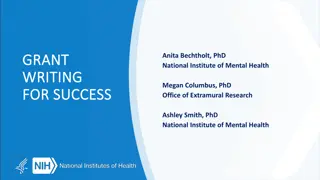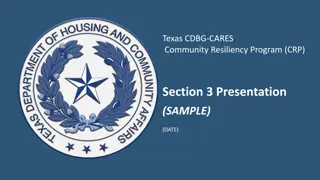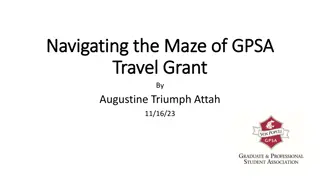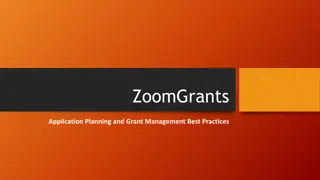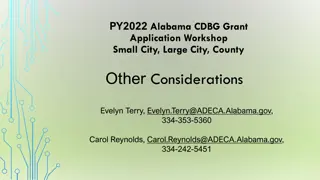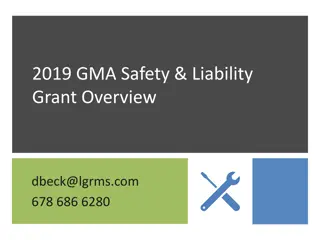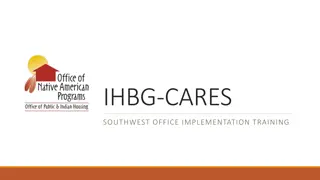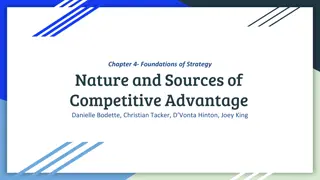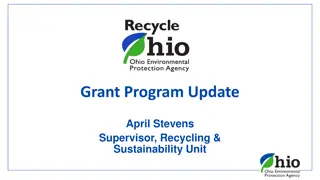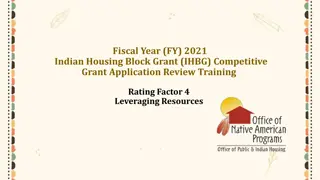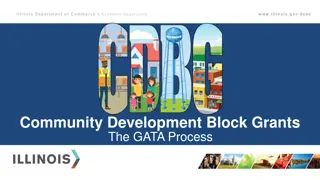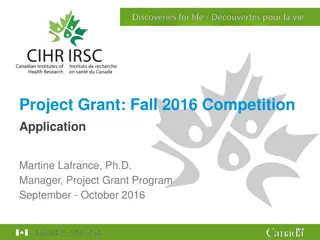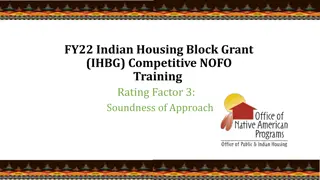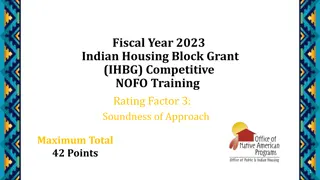IHBG Competitive Grant Application Review Training FY 2022
The Fiscal Year 2022 Indian Housing Block Grant (IHBG) Competitive Grant Application Review Training focuses on Rating Factor 5 which emphasizes Comprehensiveness, Coordination, and Preference Points. This includes addressing coordination with community members, tribal departments, and other agencies, detailing project outputs and outcomes, and earning bonus points for considerations like Climate Change and Promise Zones.
Download Presentation

Please find below an Image/Link to download the presentation.
The content on the website is provided AS IS for your information and personal use only. It may not be sold, licensed, or shared on other websites without obtaining consent from the author. Download presentation by click this link. If you encounter any issues during the download, it is possible that the publisher has removed the file from their server.
E N D
Presentation Transcript
Fiscal Year (FY) 2022 Indian Housing Block Grant (IHBG) Competitive Grant Application Review Training Rating Factor 5 Comprehensiveness & Coordination and Preference (Bonus) Points 1
Rating Factor 5: Comprehensiveness & Coordination Up to 10 points 2
Subfactor 5.1: Coordination (Up to 7 points) The applicant must address how it has designed the project and plans to implement it in coordination with community members, tribal departments, and other agencies/organizations. The applicant must describe its long-term vision for the project and how it will continue in the future.
Subfactor 5.2 Outputs & Outcomes (Up to 3 points) The applicant must; Include outputs and outcomes it strives to achieve with the project and, Describe outputs and outcomes in detail. 4
Subfactor 5.2 Outputs & Outcomes (Up to 3 points) Outputs are measured in the volume of work accomplished and must be identified by each key task proposed in the workplan. Examples of outputs could include but are not limited to: Number of housing units constructed; Number of housing units rehabilitated; Number of housing units acquired to increase the affordable housing stock; Number of homeownership units constructed or financed; Number of units connected to utilities (e.g., gas, phone or electric lines/roads/water/sewer, etc.); Number of persons assisted; and Number of jobs created.
Subfactor 5.2 Outputs & Outcomes (Up to 3 points) Outcomes are measured by the impact achieved from the outputs of the proposed project. Outcomes should be quantifiable measures or indicators that identify the change in the community, people s lives, economic status, etc. Examples of outcomes could include but are not limited to: Reduction in the number of families living in substandard housing; Reduction in overcrowding; Increase in homeownership rates; Reduction of drug-related crime or health-related hazards; Improved accessibility for person with disabilities; and Improved energy efficiency. Climate resilience.
Preference (Bonus) Points Up to 4 points 7
Preference (Bonus) Points (Up to 4 points) Climate Change (Up to 2 points) Promise Zones (PZ) (2 points) NOTE:Applicants can earn points for both Climate Change and/or Promise Zones (PZ).
Preference Points Climate Change (Up to 2 points) Propose activities that achieve the goal of supporting adaptation andincreasing resilience to the effects of climate change. Identify measures that will be incorporated in the project that will advance carbon reductions and reduce vulnerability of projects to threats identified by the U.S. Global Change Research National Climate Assessment (NCA).
Preference Points Climate Change (Up to 2 points) Threats include: Hydrological and precipitation changes; Extreme weather events; Temperature shifts; Sea level rise and; Wildfires.
Preference Points Climate Change (Up to 2 points) Applicants can earn a maximum of two (2) points overall for demonstrating one or both of the following areas under climate change; a. Climate Mitigation (Carbon reduction) (1 point) and/or b. Climate Adaptation and Resilience (1 point)
Preference Points Climate Change (Up to 2 points) a. Climate Mitigation (1 point): Show how grant activities will increase energy and water efficiency and reduce carbon emissions in the target community. Address one or a combination of the following 4 policy initiatives...
Preference Points Climate Change (Up to 2 points) a) Climate Mitigation (carbon reduction): 1) Achievement of certification through Energy Star or other green rating system; 2) Incorporation of low-carbon energy sources such as solar power; 3) Participation in voluntary Federal, State, Local or tribal energy efficiency initiatives; 4) Use of materials and construction techniques that reduce carbon emissions.
Preference Points Climate Change (Up to 2 points) Climate Mitigation Clearly describe how the identified actions measurably reduce the carbon emissions or energy or water consumption of the project below the established baseline for the target community (based on facility size and type).
Preference Points Climate Change (Up to 2 points) b) Climate Adaptation and Resilience (1 point): Show how the project will reduce vulnerabilities to one or more of the impacts of climate change identified in target community. Address one or more of the following 5 impacts...
Preference Points Climate Change (Up to 2 points) Climate Adaption and Resilience 1)Hydrological and Precipitation change including Flood Risk; 2)Extreme Weather Events; 3)Temperature Shifts; 4)Sea Level Rise; and 5)Wildfires
Preference Points Climate Change (Up to 2 points) Climate Mitigation (Carbon reduction)
Preference Points Climate Change (Up to 2 points) Climate Adaptation and Resilience
Preference Points Promise Zones (2 points) Complete/submit Certification of Consistency with Promise Zone Goals and Implementation (HUD- 50153). Signed by Promise Zone Official authorized to certify project meets criteria. View list of designated Promise Zones and persons authorized to certify at the website: https://www.hudexchange.info/programs/promise-zones/
End of Rating Factor 5 and Preference (Bonus) Points















